Varṇa, in the context of Hinduism, refers to the Brahminic ideology of hierarchizing society into classes. The ideology is epitomized in texts like Manusmriti, which classify the society into four varnas:

The Nanda dynasty ruled in the northern part of the Indian subcontinent during the 4th century BCE, and possibly during the 5th century BCE. The Nandas overthrew the Shaishunaga dynasty in the Magadha region of eastern India, and expanded their empire to include a larger part of northern India. Ancient sources differ considerably regarding the names of the Nanda kings, and the duration of their rule, but based on the Buddhist tradition recorded in the Mahavamsa, they appear to have ruled during c. 345–322 BCE, although some theories date the start of their rule to 5th century BCE.
In Indian culture, the Agnivanshi are people who claim descent from Agni, the Vedic god of fire. The Agnivanshi lineage is one of the three lineages into which the Rajput clans, Parihars divided, the others being the Suryavanshi and the Chandravanshi. According to medieval legends, there are four Agnivanshi clans: Chauhans (Chahamanas), Parihars (Pratiharas), Parmars (Paramaras) and Solankis (Chaulukyas).

The 'Bhavishya Purana' is one of the eighteen major works in the Purana genre of Hinduism, written in Sanskrit. The title Bhavishya means "future" and implies it is a work that contains prophecies regarding the future.
The Vayu Purana is a Sanskrit text and one of the eighteen major Puranas of Hinduism. Vayu Purana is mentioned in the manuscripts of the Mahabharata and other Hindu texts, which has led scholars to propose that the text is among the oldest in the Puranic genre. Vayu and Vayaviya Puranas do share a very large overlap in their structure and contents, possibly because they once were the same, but with continuous revisions over the centuries, the original text became two different texts, and the Vayaviya text came also to be known as the Brahmanda Purana.

The Padma Purana is one of the eighteen Major Puranas, a genre of texts in Hinduism. It is an encyclopedic text, named after the lotus in which creator god Brahma appeared, and includes large sections dedicated to Vishnu, as well as significant sections on Shiva and Shakti.

The Brahmavaivarta Purana is a voluminous Sanskrit text and a major Purana (Maha-purana) of Hinduism. It is an important Vaishnavism text. This Purana majorly centers around the Hindu deities Radha and Krishna.

The Markandeya Purana is a Sanskrit text of Hinduism, and one of the eighteen major Puranas. The text's title Markandeya refers to a sage in Hindu History, who is the central character in two legends, one linked to Shiva and other to Vishnu. The Markandeya text is one of the Puranas that lacks a sectarian presentation of ideas in favor of any particular god, and it is rare to read any deity being invoked or deity prayers in the entire text.
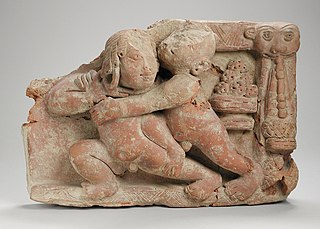
Malla-yuddha is the traditional form of combat-wrestling originating in India. It is closely related to Southeast Asian wrestling styles such as naban and is one of the two ancestors of kushti. Indian wrestling is described in the 13th century Malla Purana.
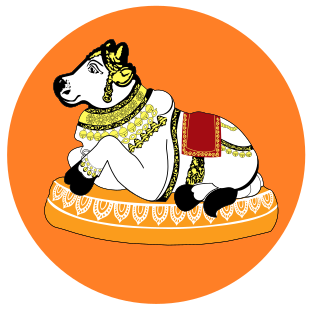
The Periya purāṇam, that is, the great purana or epic, sometimes called Tiruttontarpuranam, is a Tamil poetic account depicting the lives of the sixty-three Nayanars, the canonical poets of Tamil Shaivism. It was compiled during the 12th century by Sekkizhar. It provides evidence of trade with West Asia The Periya Puranam is part of the corpus of Shaiva canonical works.
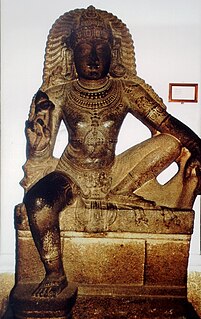
Ayyanar is a Hindu deity venerated in South India and Sri Lanka. His worship is prevalent among the Dravidian peoples. Some studies suggest that Ayyanar may have also been worshipped in Southeast Asian countries in the past. He is primarily worshipped as one of the guardian folk deities of Tamil Nadu. The temples of Ayyanar in the countryside are usually flanked by gigantic and colourful statues of him and his companions riding horses or elephants.
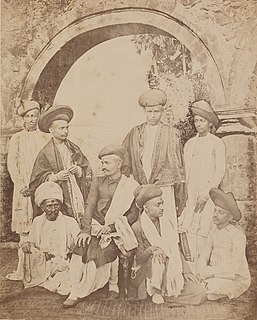
The Nagar Brahmin are a Hindu caste of India. They are primarily found in Gujarat but have a history of migration to Rajasthan, Uttar Pradesh and Madhya Pradesh, in the north and central, Maharashtra and Karnataka further west and into the south, and as far as West Bengal in the east.
The notion of a fifth Veda, that is, of a text which lies outside the four canonical Vedas, but nonetheless has the status of a Veda, is one that has been advanced in a number of post-Vedic Hindu texts, in order to accord a particular text or texts and their doctrines with the timelessness and authority that Hinduism associates with the Vedas. The idea is an ancient one, appearing for the first time in the Upanishads, but has over the centuries since then also been applied to more recent Sanskrit and vernacular texts.
Gana-Sangha or Gana-Rajya was a type of Clan structure oligarchy in ancient India.

The Matsya Purana is one of the eighteen major Puranas (Mahapurana), and among the oldest and better preserved in the Puranic genre of Sanskrit literature in Hinduism. The text is a Vaishnavism text named after the half-human and half-fish avatar of Vishnu. However, the text has been called by the 19th-century Sanskrit scholar Horace Hayman Wilson, "although a Shaivism (Shiva-related) work, it is not exclusively so"; the text has also been referred to one that simultaneously praises various Hindu gods and goddesses.
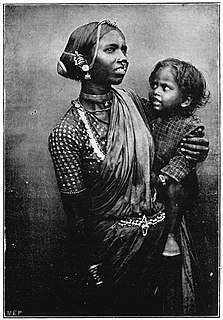
The Komati is a trading community found primarily in southern and central India, that is currently organised as a caste. The members of the Komati caste are commonly engaged in banking, money lending and other business pursuits. The community consists of many sects who are followers of Hinduism, namely the Gomata or Gauda, the Thrivarnika and the Kalinga, along with the Jaina Komatis who are followers of Jainism. Traditionally, most Komatis have been vegetarian due to ahimsa (nonviolence).
Kalikamba Nayanar, known as Kalikkamba, Kalikamba, Kalikambar, Kaliyamba, Kalikkambar, Kalikkampa(r), Kali Kambanar, Kalikkampa Nayanar and Kaliyamba Nayanar(u), is a Nayanar saint, venerated in the Hindu sect of Shaivism. He is generally counted as the forty-third in the list of 63 Nayanars. His hagiography speaks about how he cut the hand of his wife, who did not help in serving a Shaiva, devotee of the god Shiva.

Nami Nandi Adigal, also spelt as Naminandi adigal, Naminandi adikal and Naminanti Atikal, and also known as Naminandi and Naminandhi, is a Nayanar saint, venerated in the Hindu sect of Shaivism. He is generally counted as the 27th in the list of 63 Nayanars.
Amaraneedi Nayanar, also known as Amarneethi (Nayanar), Amarneeti (Nayanar), Amarniti (Nayanar), Amar-Nidhi (Nayanar) and Amarneethiyar, was a Nayanar saint, venerated in the Hindu sect of Shaivism. He is generally counted as the seventh in the list of 63 Nayanars.











